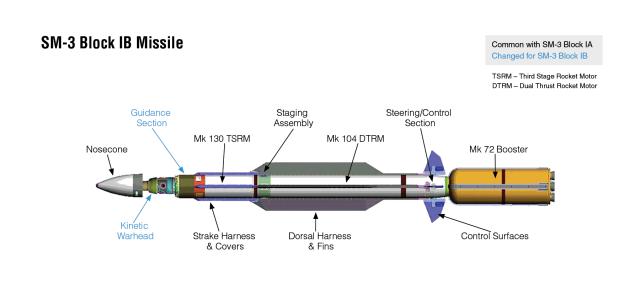Given the speed of technological change today, it is remarkable that the U.S. Navy has been using versions of the Standard Missile (SM) and its predecessors, Terrier and Tartar, for 60-some years. Other navies have replaced their missiles far more often. The explanation lies in the way in which weapons are conceived and developed. Standard has survived because it exemplifies spiral development: continual, incremental enhancements that add up to dramatic improvements.
When the Navy began to deploy the Aegis combat system in 1978, the system succeeded in part because its weapons were Standard Missiles, in service since the late 1960s. And when the Navy needed ballistic-missile defense, it developed the SM-3 interceptor from the known aerodynamics and control characteristics of the existing SM-2 for the part of the missile flight within Earth’s atmosphere. Keeping much the same missile allowed developers to refine the control systems and software. For example, the first versions of the missile homed directly toward the target. In later versions, the missile selected an energy-efficient path (homing only near the end), roughly doubling effective missile range.
It might seem intuitively better to tear up an existing system and develop an entirely new one—a process known as concurrent development. But all aspects of the new system must be developed together as an integrated entity, which can fail as a whole if any part of it fails. When something goes wrong, identifying the cause is not always easy. The Royal Navy’s former Sea Dart system illustrates the problems with concurrent development.
Like Standard and its predecessor Tartar, Sea Dart used a semiactive-homing guidance system, which relies on radiation produced by the launcher’s fire-control radar and reflected off the target. In 1960, Sea Dart’s developers predicted an excellent future for Sea Dart, because Tartar, which the United States was then selling to NATO navies, had reached the end of its potential. No one in authority in the UK seems to have realized that missiles generally are part of a larger system, and that performance can be improved both by changing the missile and by changing the system. The British eventually planned (and then canceled) an improved version, but the improvement was to have been almost entirely in the missile.
Tartar, meanwhile, had come a long way. Both it and Sea Dart were conceived as replacements for destroyer or frigate gun mounts, such as the U.S. single 5-inch/54-caliber Mk 42 gun. Tartar began as a point-defense missile with a range of about 5,000 yards. Its older brother, the two-stage Terrier, originally was to have had twice that range, but soon reached about 20,000 yards. By the late 1950s, improvements in solid-fuel rocket motors gave Tartar a nearly 20,000 yard range, and Terrier longer still.
Tartar had critical advantages. It had no separate booster, and it was controlled by tail fins that could extend automatically. Thus, it could be fired from an unmanned launcher. Terrier, on the other hand, had a massive, finned booster. The fins made for inefficient stowage, and 12 sailors had to fit the fins before a pair of missiles could be fired. That is why Terrier was stowed horizontally on all but the first two ships armed with it (the cruisers Boston [CAG-1] and Canberra [CAG-2]). Tartar and its Standard Missile successor always had a more rapid rate of fire as a result.
As originally conceived, the Advanced Missile System (which became Aegis) was to have incorporated a brand new missile. But, fortunately for the U.S. Navy, money was far too tight thanks to the Vietnam War. The beginning of work on the new system coincided with a program to solve the reliability problems of existing antiaircraft missiles, including Tartar. Instead of the missiles being discarded, they were fixed, and all the work done on flight characteristics—the missiles’ aerodynamics and control dynamics—was retained and exploited. The new, reliable Tartar became the Standard Missile Medium Range (SM-1 MR). Because it was conceived alongside the new control system, it was designed with sufficient space and weight for the programmable autopilot Aegis needed. Planned improvements in the SM-1 motor were fully exploited by the new guidance and control system. These allowed for creation a longer-range, two-stage missile called SM-1 Extended Range (SM-1 ER), derived from the even older Terrier. It still suffered from a low rate of fire, however, because it retained the finned booster.
SM-1 was developed largely to defeat the big antiship missiles the Soviets fielded. In the late 1970s, the Navy faced what was called the New Threat: the high-flying, supersonic Kh-22 (NATO designation: AS-4 “Kitchen”) missile launched by long-range bombers. Although a new rocket-ramjet missile, which could maneuver more effectively near the approaching Soviet missile, had advocates, by this time the logic of spiral development was well understood. Ships armed with SM-1 ER received the “New Threat Upgrade” to their control systems. Meanwhile, the SM-2 missile rolled out, adapted to Aegis.
Around this time, the Navy also became interested in vertical rather than mechanical launchers—the Mk 13 launcher was known with little affection as the “one-armed bandit”—for its major missiles. These one- and two-rail systems often suffered water damage because they were permanently exposed to the elements and waves shipped over the bow. Vertical launcher cells were simpler, better protected, and inherently more reliable. The short SM-2 MR was a natural fit, but designing an appropriate SM-2 ER missile with a booster (and therefore, greater length) was a difficult proposition. Ultimately, SM-2 received a large-diameter but finless booster.
When the Cold War ended in 1991, the air-defense missile role changed dramatically. The former New Threat was now over, but antiship missiles that might be launched from concealed shore launchers were rapidly being developed. These “pop-up” threats could be defeated only by extremely quick reaction. Of all the long-range air-defense systems in the U.S. inventory at the time, only the Standard Missile and Aegis were up to the challenge. Ships that had received the New Threat Upgrade (Leahy-class cruisers and Kidd-class destroyers) were equipped to meet a threat that no longer existed, and ships that had recently been refitted with it were expensive to maintain and operate compared to new Aegis destroyers and cruisers. Aegis thus went from being a high-end air defense system to the standard U.S. system, and the Leahys and Kidds were discarded. But the Standard Missile survived, in constantly improved form.
If, as it now seems, a new Cold War is getting under way, then some version of the New Threat of the 1980s also may be back. It is not yet clear to what extent a new iteration of the Standard Missile will be an adequate defense against Russia’s much-touted hypersonic threat. It may be that the next step in Aegis spiral development is a new missile body, controlled by a version of the existing system. Like the incremental improvements of the past, that would be a step toward exploiting much of what already exists to gain sufficient new performance. The alternative would be concurrent development of something entirely new and different, such as a missile-killing laser.





